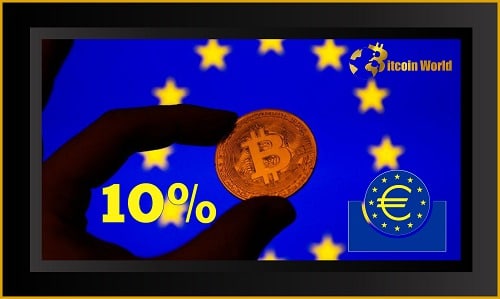Ever wondered how many Europeans are diving into the world of Bitcoin and crypto? You might be surprised to learn that according to the European Central Bank’s (ECB) latest Consumer Expectations Survey, one in every ten households in the Eurozone has hopped on the cryptocurrency bandwagon!
Eurozone Embraces Crypto: Who’s Holding and How Much?
Released just recently, this insightful survey sheds light on the growing crypto trend across six major Eurozone economies. Let’s break down the key findings:
- Widespread Adoption: On average, 10% of households in the surveyed countries hold crypto assets. That’s a significant chunk of the population exploring digital currencies!
- Dutch Lead the Charge: The Netherlands is leading the crypto adoption race with a whopping 14% of households owning crypto.
- France Playing it Cool: On the other end of the spectrum, France shows the lowest adoption rate at just 6%.
Here’s a quick look at the crypto ownership distribution across the surveyed nations:
| Country | Percentage of Households Holding Crypto |
|---|---|
| Netherlands | 14% |
| Belgium | [Data from source needed] |
| Germany | [Data from source needed] |
| Italy | [Data from source needed] |
| Spain | [Data from source needed] |
| France | 6% |
*Note: The table above includes placeholders for Belgium, Germany, Italy, and Spain as the provided content only explicitly mentions Netherlands and France. To complete the table, data from the original ECB report would be required.*
How Much Crypto Are Europeans Holding?
The survey also delved into the value of crypto holdings. Here’s a breakdown of the investment amounts:
- Small Investments Dominate: A significant 37% of crypto holders have invested up to 999 euros (approximately $1,070 USD). This suggests many are testing the waters with smaller amounts.
- Mid-Range Holdings are Common: 29% have a more substantial investment, holding between 1,000 and 4,999 euros.
- Notable Larger Investments: 13% have allocated between 5,000 and 9,999 euros to cryptocurrencies.
- Some Go Big: The remaining percentage, while not specified in detail, indicates that some individuals have invested significantly more.
Who are these Crypto Enthusiasts? Demographics Revealed
Intriguingly, the ECB survey uncovered some interesting demographic trends among crypto owners:
- The Wealthy Lead the Way: The richest 20% of respondents are most likely to hold cryptocurrencies. This isn’t entirely surprising, as they often have more disposable income for investments.
- Lower-Income Group Also Active: Interestingly, lower-income households also show a higher propensity for crypto ownership compared to the middle-income segment. This could be due to various factors, including seeking higher-risk, higher-reward investments.
- Young, Male, and Educated: The typical crypto holder profile leans towards young adult males with higher education. This demographic is generally more tech-savvy and open to new financial technologies.
- Financial Knowledge Paradox: The survey revealed a fascinating insight: individuals with either very high or very low financial knowledge are more inclined to hold crypto. This suggests different motivations – highly knowledgeable individuals might see crypto’s potential, while those with less traditional financial knowledge might be seeking alternative investment avenues.
ECB’s Stance: Proceed with Caution!
Despite the growing popularity, the ECB remains cautious about cryptocurrencies. They wasted no time reiterating their stance that cryptocurrencies are not suitable for the average individual investor. The central bank emphasizes the risks associated with crypto’s volatility and complexity.
Furthermore, the ECB is urging EU authorities to expedite the approval of new crypto asset regulations. This push comes as European legislators are working towards finalizing the Markets in Crypto Assets (MiCA) legislation, aiming to create a harmonized regulatory framework for the crypto space across Europe.
This data release is part of the ECB’s broader Financial Stability Review, highlighting the increasing attention regulators are paying to the burgeoning crypto market and its potential impact on household finances and the wider economy.
What Does This Mean for Crypto’s Future in Europe?
The ECB survey paints a picture of growing crypto adoption within the Eurozone. While still a relatively small percentage of the overall population, 10% household ownership is not insignificant and indicates increasing mainstream awareness. However, the ECB’s cautionary message and the push for stricter regulations suggest that while crypto is gaining traction, it’s also facing increased scrutiny from financial authorities.
As the MiCA legislation progresses and the crypto market continues to evolve, it will be fascinating to see how these trends shape the future of digital assets in Europe. Will crypto become a more integrated part of the financial landscape, or will regulatory pressures and inherent risks temper its growth? Only time will tell.
Related Read: The Indian Finance Minister hails blockchain technology
Disclaimer: The information provided is not trading advice, Bitcoinworld.co.in holds no liability for any investments made based on the information provided on this page. We strongly recommend independent research and/or consultation with a qualified professional before making any investment decisions.


